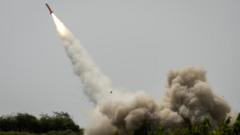In a rare glimpse into the operations of Buckley Space Force Base, the BBC reports on the Guardians who monitor missile launches globally. With proactive defense strategies against potential threats, these specialists reveal how the Space Force is transforming the landscape of military engagement, particularly regarding missile defense and operational readiness in space.
Inside the Buckley Space Force Base: The Guardians Monitoring Global Missile Threats

Inside the Buckley Space Force Base: The Guardians Monitoring Global Missile Threats
The US Space Force Guardians at Buckley Base, Colorado, play a crucial role in tracking global missile activities, demonstrating the increasing militarization of space.
At Buckley Space Force Base near Denver, Colorado, the US Space Force's elite Guardians are on constant alert, managing global missile detection and tracking from the pulse of their operations room. The Guardians are not merely personnel; they have been equipped with cutting-edge technology allowing them to react swiftly to missile launches worldwide.
In a recent drill, the command "Launch Yemen!" was met with an immediate, synchronized response from the team: "Copy, launch Yemen." Similarly, the call for "Launch Iran" echoed through the room, highlighting the urgency and stakes involved in their operations. These commendations resemble real-world scenarios, particularly calibrated to deal with tangible threats such as the missile launches from Iran towards US military positions.
Colonel Ann Hughes, overseeing these operations, recounted the weighty atmosphere during a past incident when Iran targeted a US base in response to American and Israeli military actions. These exercises emphasize the essential role played by the Guardians, as they not only detect threats but also coordinate defense measures to protect military assets and personnel, affirming their capability to avert disaster.
Under the ambitious Golden Dome program, projected to cost $175 billion, Buckley Base is poised for a seminal role. This initiative is modeled after Israel's Iron Dome and aims to bolster US missile defense capabilities amid evolving threats from nations like China and Russia, which have developed advanced missile technologies.
The space operations command, led by Lieutenant General David Miller, has marked the presence of potential dangers that necessitate the US to adapt its defense strategies. As satellite technology proliferates, Colonel Phoenix Hauser of the Space Force Intelligence unit notes the importance of preparedness against adversarial actions in an increasingly congested and contested space environment.
The conversation among space defense experts has evolved to include the potential for active conflict in space, with suggestions of “sparring” happening already among rival nations. The ramifications of this militarization are evident as the US bolsters its capabilities.
As the US Space Force frequents considerations of offensive measures, recent military operations provide a foretaste of its sophisticated capabilities. One such example is the handling of Operation Midnight Hammer against Iranian targets, demonstrating how integrative tactics and technologies were employed to maintain operational secrecy and effectiveness.
With insights from Colonel Angelo Fernandez, the US Space Force is prepared to deploy its satellite technology globally, ensuring communications superiority and operational dominance. The coordination within their various units preserves the integrity of American military operations, providing a clear reminder of the pivotal role that space plays in national security.
As the youngest military branch, the US Space Force is asserting its significance, a reality underscored by General Miller's assertion about the dependency of the US military on maintaining space superiority. The age of active defense and conflict readiness in space is upon us, heralding a new chapter in military engagement that borders on the extraordinary.



















